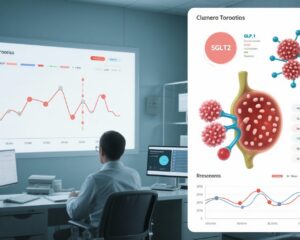Highlight
This real-world, multicentre study demonstrates that initiation of SGLT2 inhibitors in patients with type 2 diabetes and chronic kidney disease is associated with a slower decline in estimated glomerular filtration rate (eGFR) and significant improvements in albuminuria compared with other glucose-lowering medications, including GLP-1 receptor agonists (GLP-1RA). These data reinforce SGLT2 inhibitors as a key therapeutic option to preserve kidney function and delay CKD progression in this high-risk population.
Study Background and Disease Burden
Chronic kidney disease (CKD) is a common and serious complication affecting people with type 2 diabetes (T2D), contributing substantially to morbidity, mortality, and healthcare costs worldwide. Progressive loss of kidney function in T2D leads to end-stage kidney disease (ESKD), necessitating dialysis or transplantation and impairing quality of life. Despite advances in diabetes care, many patients continue to experience substantial renal decline. Identifying effective treatments that preserve kidney function and slow CKD progression remains a critical unmet need.
Sodium-glucose cotransporter 2 inhibitors (SGLT2i) have emerged as a transformative class of glucose-lowering drugs with additional cardiovascular and renal benefits. Clinical trials have shown that SGLT2i reduce progression of kidney disease in T2D, but data from real-world clinical practice, especially with direct comparisons to other glucose-lowering medications (GLMs), are important to confirm and extend trial findings. The DARWIN-Renal study addresses this gap by evaluating long-term renal outcomes in T2D patients with CKD treated with SGLT2i versus other GLMs in routine clinical settings.
Study Design
DARWIN-Renal is a retrospective, multicentre observational study including patients aged 18 to 80 years with T2D and established CKD who initiated treatment with either an SGLT2 inhibitor or other GLMs between 2015 and 2020. CKD was identified based on reduced estimated glomerular filtration rate (eGFR) and/or albuminuria presence. The comparator group included various glucose-lowering drugs, encompassing agents such as GLP-1 receptor agonists.
The primary outcome was the rate of change in eGFR over time, a key marker of kidney function. Secondary outcomes comprised albuminuria category changes and the incidence of adverse kidney events, such as a sustained 40% reduction in eGFR. Propensity score matching was employed to minimize baseline differences between groups, balancing key variables like age, body mass index (BMI), HbA1c, and baseline kidney function to approximate randomized comparisons in this observational dataset.
Key Findings
After propensity score matching, the study analyzed 2,020 patients in each group (SGLT2i and other GLMs). Patients had a mean age of 63 years, BMI of 32 kg/m2, and mean HbA1c of 8.2%, reflecting a typical population with T2D and CKD in clinical practice.
The primary analysis demonstrated that patients initiating SGLT2 inhibitors experienced a significantly slower decline in eGFR compared to patients starting on other glucose-lowering medications. The mean difference in eGFR decline was 1.43 mL/min/1.73 m2 per year favoring SGLT2i (p=0.048), indicating a clinically meaningful preservation of kidney function associated with this class.
Albuminuria, a prognostic marker for kidney disease progression, improved significantly more among SGLT2i new users. Patients treated with SGLT2 inhibitors had a higher probability of improving their albuminuria category (hazard ratio 1.17; p=0.007), suggesting beneficial effects on kidney damage beyond filtration rates.
Further, initiation of SGLT2i was associated with a substantially lower risk of adverse kidney outcomes, including a sustained ≥40% decline in eGFR (hazard ratio 0.63; p=0.004). This reinforces the protective effect against clinically relevant kidney function loss.
A subgroup analysis comparing SGLT2 inhibitors to GLP-1 receptor agonists (n=1,266 per group) revealed that the eGFR slope remained significantly better with SGLT2i, with a mean difference of 0.62 mL/min/1.73 m2 per year (p=0.046). This finding highlights that the kidney protection afforded by SGLT2 inhibitors extends beyond improvements achievable with GLP-1RA, another drug class with established cardiovascular and renal benefits.
The study did not report major safety concerns specifically attributable to SGLT2i within the observational period, consistent with prior clinical trial safety data.
Expert Commentary
The findings from the DARWIN-Renal study add robust real-world evidence supporting clinical trial data that position SGLT2 inhibitors as a cornerstone intervention to slow CKD progression in patients with T2D. The use of propensity score matching strengthens the validity of comparisons, although residual confounding cannot be entirely excluded.
Mechanistically, SGLT2 inhibitors reduce glomerular hyperfiltration and proteinuria, improve metabolic parameters, and exert direct renal protective effects via hemodynamic and anti-inflammatory pathways. Their efficacy in reducing eGFR decline and albuminuria aligns with these biological insights.
Current clinical guidelines increasingly recommend SGLT2i for patients with T2D and CKD, irrespective of glycemic control, reflecting their renal and cardiovascular benefits. This study bolsters their preferential use over other GLMs to optimize kidney outcomes. However, individual patient circumstances—such as baseline kidney function, comorbidities, and drug tolerability—remain central to therapeutic decision-making.
Limitations include the retrospective design and potential for unmeasured confounders despite matching. Longer follow-up and randomized prospective studies remain valuable to confirm durability of renal benefits. Additionally, applicability to populations with advanced CKD or diverse ethnic groups requires further investigation.
Conclusion
The DARWIN-Renal study compellingly demonstrates that initiating SGLT2 inhibitors in patients with type 2 diabetes and chronic kidney disease is associated with significant preservation of kidney function and improvement in albuminuria compared with other glucose-lowering therapies, including GLP-1 receptor agonists. These findings further establish SGLT2i as the most effective pharmacologic option to mitigate CKD progression in T2D. Implementation in routine clinical practice promises major benefits in reducing progression to end-stage kidney disease and associated complications.
Future research should focus on longer-term outcomes, head-to-head comparisons with emerging therapies, and mechanistic studies to refine patient selection and optimize renal protection.
References
- Fadini GP, Longato E, Morieri ML, et al. Long-term preservation of kidney function with SGLT-2 inhibitors versus comparator drugs in people with type 2 diabetes and chronic kidney disease. Diabetes Obes Metab. 2025 Sep;27(9):5182-5191. doi:10.1111/dom.16569.
- Heerspink HJL, Stefánsson BV, Correa-Rotter R, et al. Dapagliflozin in Patients with Chronic Kidney Disease. N Engl J Med. 2020;383(15):1436–1446.
- Neal B, Perkovic V, Mahaffey KW, et al. Canagliflozin and Cardiovascular and Renal Events in Type 2 Diabetes. N Engl J Med. 2017;377(7):644–657.
- American Diabetes Association. Standards of Medical Care in Diabetes—2023. Diabetes Care. 2023;46(Suppl 1):S1–S100.
- Kidney Disease: Improving Global Outcomes (KDIGO) Diabetes Work Group. KDIGO 2020 Clinical Practice Guideline for Diabetes Management in Chronic Kidney Disease. Kidney Int Suppl. 2020;10(1):S1–S115.


